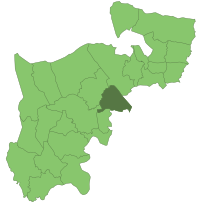Willesden (parish)
| Willesden | |
|---|---|
 Willesden within Middlesex in 1961 |
|
| Area | |
| • 1911 | 4,384 acres (17.74 km2) |
| • 1931 | 4,385 acres (17.75 km2) |
| • 1961 | 4,633 acres (18.75 km2) |
| Population | |
| • 1911 | 154,214 |
| • 1931 | 184,434 |
| • 1961 | 171,001 |
| Density | |
| • 1911 | 32/acre |
| • 1931 | 42/acre |
| • 1961 | 37/acre |
| History | |
| • Created | 1874 |
| • Abolished | 1965 |
| • Succeeded by | London Borough of Brent |
| Status |
Local board (1874 - 1894) Urban district (1894 - 1933) Municipal borough (from 1933) |
| Government | Willesden Urban District Council Willesden Borough Council |
| • HQ | Dyne Road, Kilburn |
| • Motto | Labore est Orare (To Work is to Pray) |
 Coat of arms of the borough council |
|
Willesden was a local government district in the county of Middlesex, England from 1874 to 1965. It formed part of the Metropolitan Police District and London postal district. Willesden was part of the built-up area of London and bordered the County of London to the east and south.
It was formed as a Local government district in 1874, became an urban district in 1894 and was incorporated as a municipal borough in 1933. In 1901 the population was 114,811. The population peaked in 1931 at 184,434 and by 1961 it had fallen to 171,001. It occupied 4,384 acres (17.74 km2) in 1911 and 4,633 acres (18.75 km2) in 1961. It included the districts of Kilburn, Harlesden, Neasden, Willesden, Cricklewood, Dollis Hill and Brondesbury. The district was abolished in 1965 and its former area transferred to Greater London, merging with the Borough of Wembley to form the London Borough of Brent.
The offices of the local board were established at Dyne Road, Kilburn in 1891. These were later enlarged to become Willesden Town Hall. Following the formation of the London Borough of Brent, administration was transferred to Wembley, and the town hall was demolished in 1972.
The urban district council elections were not conducted on party political lines until 1910, when pro-Conservative Moderates gained a majority, with Progressive and Labour councillors forming the opposition.
By 1921, Labour was having an increased influence on the council and this led to the formation of an anti-Labour Ratepayers Association, who held power until 1933. From 1933 to abolition in 1965 the borough council was Labour-controlled for all but one year.
...
Wikipedia
